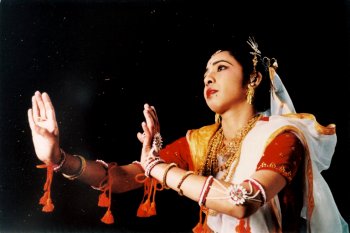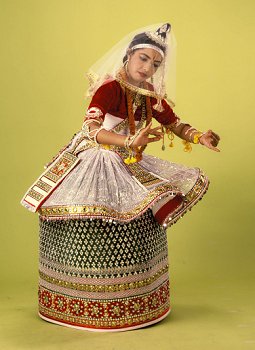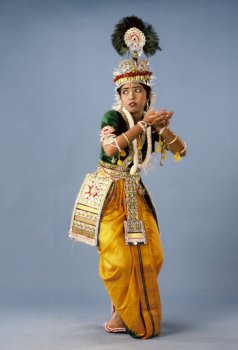
|
 |

|
 |
Dr. Sohini Ray: Manipuri dance is an integral part of life - Vijay Shanker e-mail: vijaydance@gmail.com January 7, 2013  California based anthropologist, scholar and Manipuri exponent Dr. Sohini Ray is currently presenting her multi-media production 'Bhaktirasgi Maangal Khonjel' described as sounds and lights of devotion pertaining to the Manipuri dances, in various cities of India. This presentation successfully explores as to how Manipuri dance forms an integral part of life in Manipur, wherein every occasion either social or religious is considered incomplete without Manipuri dance. Having received a grant from the University of California at Los Angeles (UCLA), Sohini travelled to various places in Manipur and conducted research on the significance of Manipuri dance as a performing art and its transition from temples to the auditorium. While this production is considered one of the best collections of Manipuri dance, it was also the final nominee for the 2010 Margaret Mead Award given by the Society of Applied Anthropology of the American Anthropological Association for successfully establishing dance as an application of anthropology. Dr. Sohini Ray reveals as to how she was fascinated by Manipuri dance at a tender age, her association with her mentors Guru Bipin Singh and the Jhaveri sisters, the inter-relationship between dance and anthropology and her journey as an exponent and much more.  Why were you fascinated by Manipuri dance and not any other style? I hail from a family of music lovers. In spite of being a physicist, my father had a passion for the sitar, my mother played the piano and my grandmother was a visual artist. I was initiated into Manipuri at a tender age. At the age of seven I was privileged to become the disciple of Guru Bipin Singh and slowly I developed a passion for Manipuri dance. At the age of 14, I received the national scholarship from the Government of India and that was a real boost up for me. Did your parents approve of your passion for dance? They were never thrilled about my dance and advised me otherwise. I was a rebel and was determined to continue learning dance, but I never neglected my academics. I stood class first in the Bachelors and Masters degree in Anthropology from University of Calcutta and in 1992, I chose to move to United States to pursue an MA in dance from UCLA. Ever since, I have lived and worked there. How would you describe your relationship with Guru Bipin Singh and the Jhaveri Sisters? Guru Bipin Singh was a fatherly figure for me and he persuaded my parents to let me continue dance. Possibly he had a vision that someday I would do well in dance. While the controversy was on in 1994, I stayed with him for three months. As far as the Jhaveri Sisters are concerned I have performed with them on various occasions. Besides being amazing dancers, they are wonderful human beings too. Darshanaben has particularly guided and helped me a lot concerning my performances in India. How did this idea about making a film on Manipuri dance start? While I was doing my Masters in dance, I used to talk about Manipuri dance and people were completely ignorant about it. They had also never heard about Manipuri state, hence I decided I must make a film and that would also become an enriching experience for me. I was fortunate to receive a grant from UCLA. How could you relate dance to anthropology? Anthropology is the science of humanity and since dance is again related to human beings, I could co-relate the social and religious aspect wherein Manipuri dance forms an integral part. Every occasion whether religious or social, the birth of a child, the marriage, death or festive occasions like Janmaashtami is always celebrated with Manipuri dance and music. Anthropology is close to the study of people and their sentiments. Hence it enriched my vision as a dancer.  Can you tell us about Guru Bipin Singh's contributions to the art form? The most important contribution was that he was a pioneer in teaching females the drum dance known as 'Pung Cholom.' Traditionally, only male dancers were performing the drum dance as it involved mastery over performing rhythmic patterns and also jumping and moving in circular jumps which was not an easy task and needed lot of practice. As you are possibly aware Manipuri dance is broadly based on both tandava and lasya. Pertaining to tandava, Guruji has made certain innovations like the inclusion of Krishna Madhura, the athletic Cholom dance and the martial art form known as Thang-ta. We also have Sankirtan and Lai Haroba. While sankirtan is invocatory, Lai Haroba is a festival dance. All the dances are based on Vaishnavism. After doing research with other exponents, I realized that the technique is similar but the context is different. In the film, you must have noticed that there are dancers who were also singing with lot of emotion but these days in the auditorium program, the singer sings separately and the dancer dances and emotes. The expressional dance is quite soft and not distinct sometimes. Why? Unlike Bharatanatyam, in Manipuri the expressions are soft and subtle and it is more subdued. Here again it is angika abhinaya that is projected and not the natya element. Tell us about your dance institute in US. I am the founder and artistic director of Manipuri Dance Visions based in Los Angeles. The response I get is amazing. I won the prestigious Lestor Horton award in 2008 for my production 'Gita Govinda.' This award is considered equivalent of the Grammy and it is given for live concert dance. How do you keep yourself fit? I am into yoga and rigorous exercising and serve as a dancer with complete devotion. That would keep you both mentally and physically fit. Contact Sohini Ray: sohiniray7@gmail.com Comments Lai Haraoba is not based on Vaishnavism. Ras Lila is based on Radha Krishna, but adapted from Lai Haraoba dance form, the ancient Meitei dance tradition. Many Indian dancers try to link Lai Haraoba to Siva or some other Hindu mythology to please Indian audience. But, Lai Haraoba and Ras Lila are two different forms. - Anonymous (Jan 21, 2013) Post your comments Unless you wish to remain anonymous, please provide your name and email id when you use the Anonymous profile in the blog to post a comment. All appropriate comments posted with name & email id in the blog will also be featured in the site. |